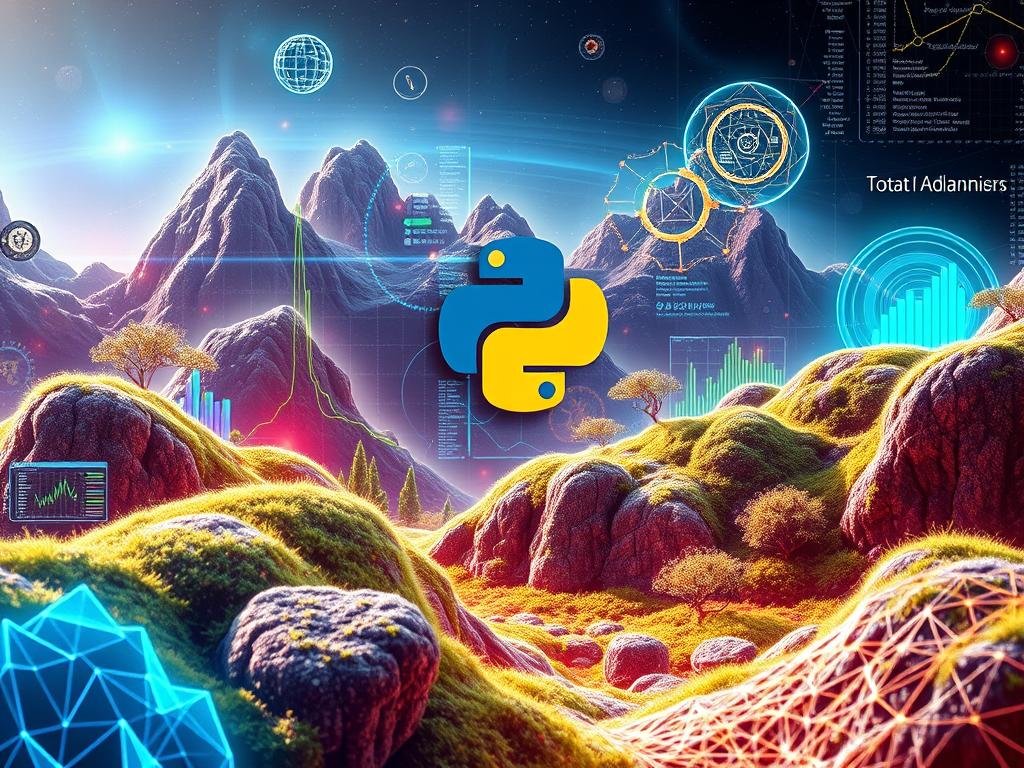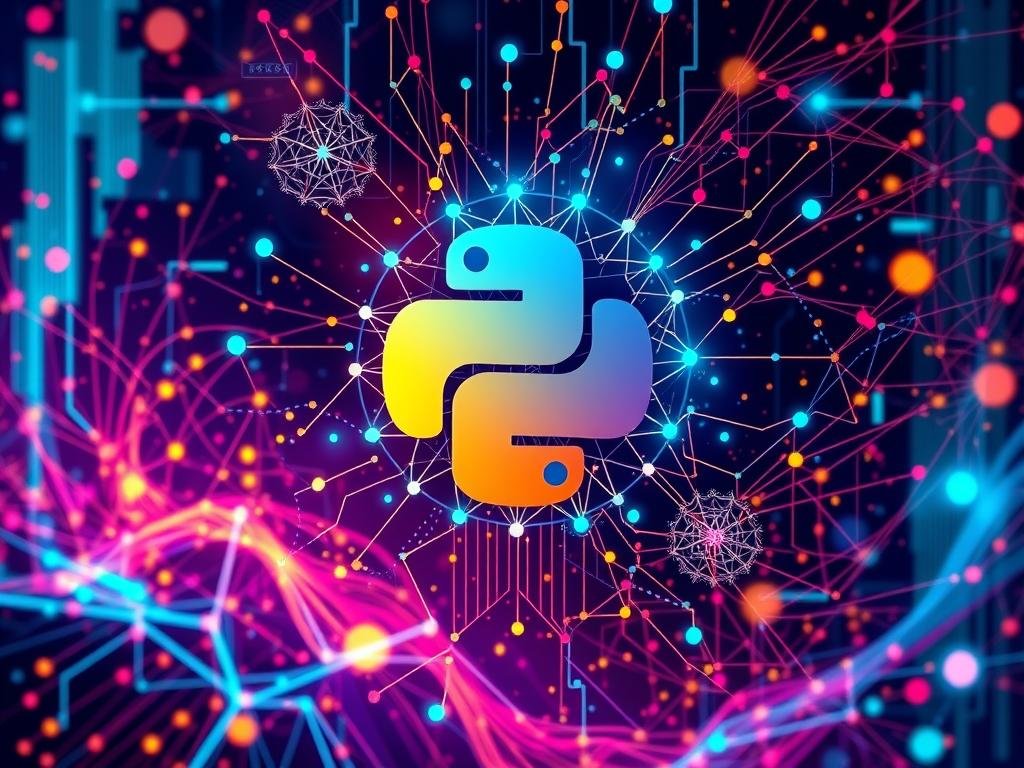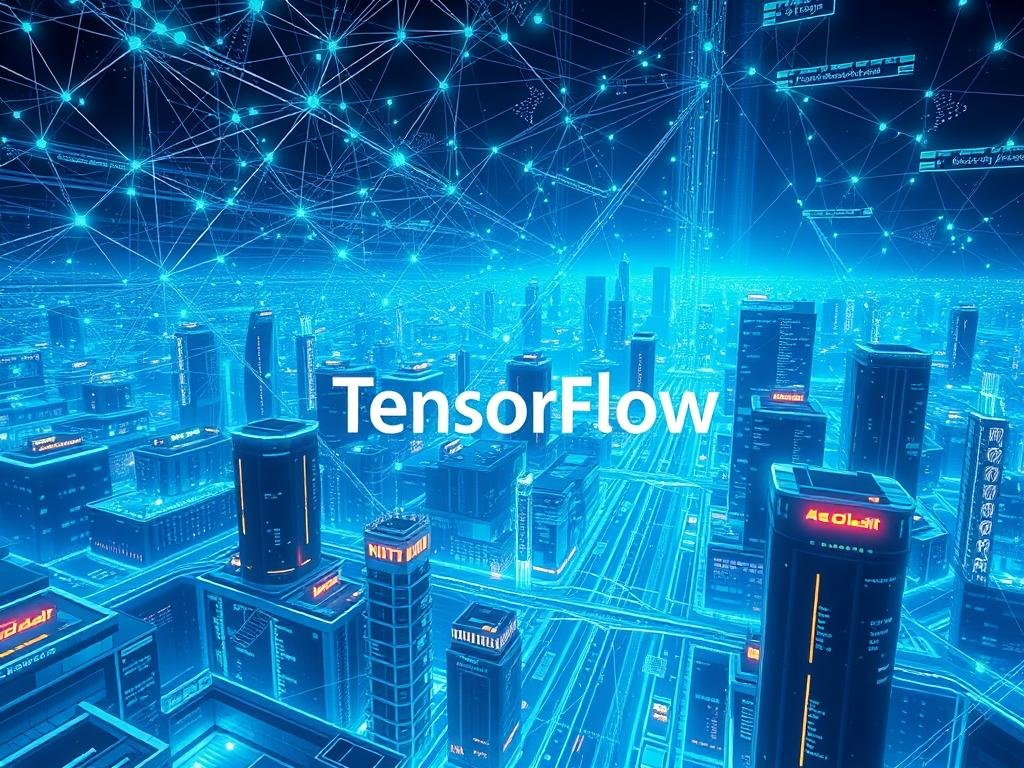Did you know the global machine learning market is set to hit $209 billion by 2029? This huge growth shows how python machine learning can unlock your data’s full potential. In this guide, you’ll learn why Python is the top choice for data scientists. You’ll see how it can help you tap into your data’s endless possibilities.
Python machine learning is changing how businesses work. It helps predict customer behavior and automate decisions. By learning the key libraries and techniques, you can create powerful machine learning models. These models turn raw data into useful insights, helping you make smarter choices.
Get ready to explore the world of data science and data analytics with Python. Its unmatched versatility and simplicity make it easy to unlock your data’s power. Python helps you discover new things and stay at the forefront of artificial intelligence.
Key Takeaways
- Discover the transformative power of Python in the field of machine learning
- Explore the essential libraries and techniques that enable you to harness the full potential of your data
- Learn how to build advanced machine learning models that drive intelligent decision-making
- Unlock the boundless potential of your data and stay ahead of the curve in the world of artificial intelligence
- Understand the versatility and ease of use that make Python the language of choice for data scientists
The Boundless Potential of Python for Machine Learning
Python has become the top choice for machine learning and data science. It’s easy to use and has a huge open-source ecosystem. This makes it perfect for all kinds of data projects, from quick tests to big machine learning workflows.
Why Python Reigns Supreme for Data Science
Python is great for working with data because it’s easy to understand and flexible. It has many Python libraries for data science and machine learning. This lets developers build strong data pipelines and try out new algorithms fast.
Versatility and Ease: Python’s Winning Combination
Python programming is amazing because it works well with lots of data science tools and machine learning frameworks. It’s perfect for handling different types of data, like numbers, text, or images. This means you can solve many problems easily.
| Python Library | Use Case |
|---|---|
| NumPy | Numerical computing and data manipulation |
| Pandas | Data analysis and manipulation |
| Matplotlib | Data visualization |
| Scikit-learn | Machine learning algorithms and model development |
| TensorFlow | Deep learning and neural network modeling |
Whether you’re an expert or new to data science, Python is the best choice. Its huge open-source ecosystem and simple syntax help you get the most out of your data. This leads to powerful machine learning solutions.
Mastering the Essentials: Python Libraries for Machine Learning
In the vast world of Python, many powerful libraries have become key to machine learning. They help with everything from getting your data ready to building and checking models. Let’s explore the top Python libraries that will boost your machine learning skills.
Scikit-learn: The Swiss Army Knife of Machine Learning
Scikit-learn is a detailed and easy-to-use library. It has many algorithms and tools for data preprocessing, feature engineering, and model training. It’s great for tasks like classification, regression, or clustering, making it easy to start your projects.
TensorFlow: The Deep Learning Powerhouse
For deep learning, TensorFlow is a big deal. It lets you create, train, and use complex neural networks easily. It’s perfect for tasks like computer vision and natural language processing, thanks to its flexibility and growth.
Keras: The High-Level Neural Networks API
Keras works with TensorFlow to make building deep learning models easier. Its simple syntax and design let you quickly try out different models. This makes Keras a top pick for many machine learning experts.
| Library | Specialty | Key Features |
|---|---|---|
| Scikit-learn | General Machine Learning |
|
| TensorFlow | Deep Learning |
|
| Keras | Deep Learning |
|
These are just a few key python machine learning libraries for your data science toolkit. Learning these tools well will help you unlock your data’s full potential. You’ll be able to create smart apps that change industries.
Unleashing the Power of Scikit-learn
Scikit-learn is a top choice for Python users looking to master machine learning. It guides you through data prep, feature creation, model training, and checking how well they work. Get ready to discover your data’s full potential and make smart solutions that break new ground.
Streamlining Data Preprocessing and Feature Engineering
Good data is key to a great machine learning project. Scikit-learn makes it easy to get your data ready. It helps with missing values and turning text into numbers your models can use.
Effortless Model Training and Evaluation
Training and checking your models is easy with Scikit-learn. It has many algorithms, from simple to complex. Use your data prep and feature work to train your models, and Scikit-learn’s tools will help you see how well they do.
Scikit-learn is perfect for both new and experienced data scientists. Start exploring its many features and use your data to make something truly innovative. Your work will make a big difference.
Diving into TensorFlow: The Deep Learning Powerhouse
TensorFlow is a top player in deep learning. It’s an open-source framework from Google that changes how we build neural networks. You’ll find it easy to create, train, and improve complex deep learning models with TensorFlow.
Building and Training Neural Networks with Ease
TensorFlow stands out for neural networks. It lets you build model architectures that fit your needs. This is true for tasks like computer vision and natural language processing.
Training models with TensorFlow is simple. It uses top-notch algorithms and neural networks techniques. This helps you get the most out of your data, making your projects successful.
| Feature | Benefit |
|---|---|
| Flexible Model Architecture | Effortlessly design and implement complex deep learning models to tackle a wide range of challenges. |
| Efficient Model Training | Leverage TensorFlow’s powerful optimization algorithms to train your neural networks with speed and precision. |
| Seamless Integration | Seamlessly combine TensorFlow with other machine learning libraries and tools for a comprehensive workflow. |
Explore the endless possibilities with tensorflow. It makes deep learning easy in your projects. TensorFlow’s user-friendly API and strong features make creating and training neural networks simple.
“TensorFlow is a game-changer in the world of deep learning. Its flexibility and ease of use have empowered developers and researchers alike to push the boundaries of what’s possible with neural networks.”
Keras: The High-Level Neural Networks API
If you love Python, you know how deep learning can change things. But making and training neural networks can be hard. That’s where Keras comes in – it makes it easier to work with deep learning models.
Keras sits on top of TensorFlow and is easy to use. It lets you focus on your machine learning projects without worrying about the details. With Keras, you can:
- Easily build and train complex neural networks, including convolutional networks, recurrent networks, and more.
- Optimize your models by fine-tuning hyperparameters and experimenting with different layer configurations.
- Seamlessly integrate Keras with other Python libraries, such as scikit-learn and NumPy, for a comprehensive machine learning workflow.
Keras is great because it’s flexible. It works well for both experienced data scientists and beginners. Keras makes it easy to quickly test and improve your deep learning models. It lets you focus on the big picture, not the small details.
“Keras is the future of deep learning.” – François Chollet, Creator of Keras
As you learn more about Python machine learning, check out Keras. It’s amazing for model building, model training, and model optimization. Keras will be a key tool in your data science work, opening up new possibilities and driving your projects forward.
python machine learning: Fueling Intelligent Applications
Natural Language Processing: Unlocking Text-based Insights
Discover the power of natural language processing (NLP) with Python. It opens up a world of insights from text. Python’s machine learning can change how we use and understand unstructured data.
Python’s NLP libraries, like NLTK and spaCy, make complex text analysis simple. You can analyze sentiment in customer reviews or create chatbots that seem human.
Use Python’s NLP tools to make text data easier to work with. Find patterns and insights that can help your business grow. Python’s machine learning can make your apps smarter and give you an edge.
| NLP Task | Python Library | Key Capabilities |
|---|---|---|
| Sentiment Analysis | NLTK, TextBlob, Vader | Determine the emotional tone of text, identify positive, negative, or neutral sentiments |
| Named Entity Recognition | spaCy, NLTK | Identify and classify important entities (people, organizations, locations, etc.) in text |
| Text Summarization | gensim, sumy | Automatically generate concise summaries of lengthy text documents |
| Language Modeling | Transformers, GPT-2 | Generate human-like text, power chatbots and virtual assistants |
Tap into Python’s NLP power for a new era of smart apps. These apps can understand and respond to text data with great accuracy and speed.
Computer Vision: Seeing the World Through Data
Python is not just for text. It’s also great for computer vision. This lets you create smart systems that can see and understand the world. We’ll look at how Python and deep learning can make advanced computer vision apps. These include object detection, image classification, facial recognition, and more.
Object Detection and Image Recognition Unleashed
Computer vision is changing how we see and interact with the world. With deep learning models in Python, you can train systems to spot and recognize objects. This is key for smart surveillance, self-driving cars, and image search engines.
Python has libraries like OpenCV and Keras for building these systems. These tools use deep learning to find objects, classify images, and even recognize faces. The uses of these technologies are endless, from retail to healthcare and transportation.
“Computer vision is the future, and Python is the language that’s making it happen.”
Exploring computer vision and image recognition with Python opens up new possibilities. It lets you create systems that change how we see and interact with the world. With deep learning and Python, you can make a big impact in many areas.
Revolutionizing Industries with Python Machine Learning
Python machine learning is changing the game, not just in labs or personal projects. Big industries are using Python machine learning to change how they work. They’re making better decisions and giving customers amazing experiences.
Healthcare, finance, retail, and transportation are all using machine learning applications to stay ahead. They’re getting data-driven insights from predictive analytics and automated decision-making. This helps them innovate and grow.
In healthcare, machine learning is changing patient care. It helps find diseases early, create treatment plans, and improve health outcomes. Finance uses it for better risk management, fraud detection, and investment strategies. Retailers use it to make shopping personal, manage inventory, and set prices.
The transportation sector is also seeing big changes. It’s using Python machine learning for better routes, traffic management, and even self-driving cars. This technology is changing how industries make decisions and serve customers.
The future of business is all about Python machine learning. As more industries use this tech, the possibilities for change are endless. Are you ready to unlock your data’s full potential and change your industry?
“Python machine learning is the key to unlocking the full potential of our data and driving innovation across industries.”
Best Practices for Deploying Machine Learning Models
Starting your journey in Python machine learning is exciting. But the real challenge is deploying your models in real-world settings. It’s important to make sure your models are scalable, robust, and production-ready. This section will guide you through the key steps of machine learning model deployment, model monitoring, and keeping your models strong.
Optimizing for Scalability and Robustness
Your machine learning models need to be scalable and robust to succeed. Start by checking how well your models perform and how much resources they need. Look for bottlenecks and find ways to improve. Use model compression, feature selection, and distributed computing to make your models better. This way, they can handle more data and user needs.
It’s also crucial to make your models robust. Use good error handling to deal with unexpected data. Test your models well, including stress tests and real-world scenarios. This helps find and fix weaknesses, making your models more reliable.
Continuous Monitoring and Adaptation
Model deployment doesn’t stop after you launch. You need to keep monitoring and updating your models. Set up strong monitoring systems to watch performance, find odd data, and see if predictions change. By always improving and updating your models, they stay useful and relevant.
Deploying machine learning models is a continuous effort, not just a one-time task. By following these best practices, you’ll make your Python applications successful for a long time. This unlocks the power of data-driven decisions.
Embracing Ethical and Responsible Machine Learning
Machine learning is changing many industries and creating new applications. It’s important to think about the ethics of these technologies. We need to focus on ethical and responsible machine learning.
At the core of ethical machine learning is reducing model bias, protecting data privacy, and making algorithms accountable. By following these principles, we can use Python-driven machine learning in a responsible way.
To do this, consider these strategies:
- Addressing Model Bias: Test your machine learning models for biases and work to remove them. This ensures fair and just results.
- Safeguarding Data Privacy: Use strong data protection, follow privacy laws, and be open about how data is used.
- Ensuring Algorithmic Accountability: Have clear rules for decision-making, explain model outputs, and let people understand and question the algorithms.
By following these ethical and responsible machine learning principles, we can fully use Python-driven data science. We can do this while keeping values like integrity, fairness, and transparency. Together, we can make a future where innovation and ethics are both important.
| Principle | Description | Key Strategies |
|---|---|---|
| Mitigating Model Bias | Ensuring machine learning models are free from biases that could lead to unfair or discriminatory outcomes. |
|
| Protecting Data Privacy | Safeguarding the privacy and security of the data used to train and deploy machine learning models. |
|
| Ensuring Algorithmic Accountability | Establishing clear decision-making processes and empowering stakeholders to understand and challenge the algorithms. |
|
“Ethical machine learning is not just a nice-to-have, but a critical imperative as these technologies become more pervasive in our lives. By upholding the highest standards, we can unlock the full transformative potential of Python-driven data science while safeguarding the values of fairness, privacy, and transparency.”
Conclusion: Unleashing the Full Potential of Data
This guide has shown you how to master Python-driven machine learning. You now have the tools to turn data into useful insights. This can help you make better decisions and advance your projects and career.
The future of machine learning looks bright. By using the techniques from this article, you’re ready for the changing data science world. Whether you want to change your industry, find new ways to innovate, or start a career in AI, you’re set.
Now, you can unlock your data’s full potential with Python machine learning. Use Scikit-learn, TensorFlow, Keras, and other top libraries to solve tough problems. The possibilities are endless, and with your skills, you can shape the future.
FAQ
Why is Python the preferred language for machine learning?
Python is loved for its easy-to-read code and vast library collection. It’s perfect for working with data. Its flexibility and a strong community make it the top choice for those in data science and machine learning.
What are the essential Python libraries for machine learning?
Key libraries for machine learning in Python are Scikit-learn, TensorFlow, and Keras. They make your work easier, from getting data ready to testing models.
How can Scikit-learn simplify my machine learning projects?
Scikit-learn offers tools for getting data ready and building models. It makes your projects faster and easier with its simple APIs.
What are the benefits of using TensorFlow for deep learning?
TensorFlow is a top choice for deep learning, thanks to Google. It has an easy API for creating and improving complex models. This is great for tasks like image and text analysis.
How can Keras help me build and train deep learning models?
Keras makes working with deep learning models easier. It’s built on TensorFlow and focuses on the important parts of your project. This lets you focus on the big picture without getting lost in details.
How can Python’s machine learning capabilities be applied to natural language processing?
Python’s NLTK and spaCy libraries are great for text analysis. They help you create smart chatbots and language models. You can also do tasks like sentiment analysis and text classification.
What are the applications of computer vision using Python machine learning?
Python is great for computer vision, helping systems understand images and videos. You can build models for object detection, facial recognition, and more. This is key for self-driving cars and other advanced tech.
How are industries leveraging Python machine learning to drive innovation?
Top industries are using Python machine learning to change the game. They’re improving healthcare, finance, retail, and more. Python helps them make better decisions and offer better services.
What are the best practices for deploying machine learning models in production?
Deploying models in real life needs careful planning. You must make sure they work well, are fast, and can handle unexpected situations. This keeps them reliable and effective.
How can I ensure ethical and responsible development of machine learning models?
It’s important to think about ethics when using machine learning. You need to avoid bias, protect data, and be accountable. This ensures Python machine learning is used responsibly and for the greater good.




